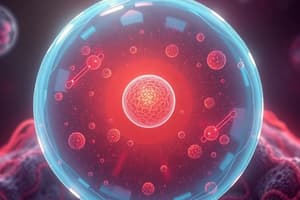Podcast
Questions and Answers
Which component constitutes about 70% or more of the cell's content?
Which component constitutes about 70% or more of the cell's content?
- Lipids
- Water (correct)
- Carbohydrates
- Proteins
Lysosomes are responsible for providing intracellular digestion.
Lysosomes are responsible for providing intracellular digestion.
True (A)
What is the primary function of the Golgi apparatus?
What is the primary function of the Golgi apparatus?
Processing and packaging substances received from the endoplasmic reticulum.
The lipid bilayer of the cell membrane is primarily composed of ________.
The lipid bilayer of the cell membrane is primarily composed of ________.
Which of the following ions is NOT typically found in smaller quantities inside cells?
Which of the following ions is NOT typically found in smaller quantities inside cells?
Match the following cell structures with their primary function:
Match the following cell structures with their primary function:
Integral proteins are only found on the surface of the cell membrane.
Integral proteins are only found on the surface of the cell membrane.
What are secretory vesicles formed from?
What are secretory vesicles formed from?
Flashcards are hidden until you start studying
Study Notes
Cell Components and Functions
- The human body contains approximately 100 trillion cells.
- Cells are the fundamental unit of the body, combining with extracellular matrix to form organs.
- Cells vary functionally across different tissues.
- Protoplasm, composed mainly of water (70% or more), makes up cell substance.
- Important ions within cells include potassium (K+), magnesium (Mg+), phosphate (PO4-), sulfate (SO4-), and bicarbonate (HCO3-).
- Trace quantities of sodium (Na+), chloride (Cl-), and calcium (Ca+) are also present.
- Proteins in cells serve as structural components or perform functional roles.
- Lipids, such as phospholipids and cholesterol, are crucial for membrane structure.
- Carbohydrates contribute to glycoproteins and provide nutrition for cells.
Membrane Structure of Cells
- Composed of lipids and proteins, forming a lipid bilayer primarily made of phospholipids.
- The membrane is impermeable to water-soluble substances like ions, glucose, and urea.
- Permeable to fat-soluble substances, including oxygen (O2), carbon dioxide (CO2), and alcohol.
- Integral and peripheral proteins serve various functions, including forming channels, carrier proteins, enzymes, and receptors for water-soluble chemicals like peptide hormones.
Endoplasmic Reticulum (ER)
- Granular ER contains ribosomes, facilitating protein synthesis from RNA and proteins.
- Agranular ER synthesizes lipid molecules, especially prominent in liver cells due to high protein synthesis activity.
Golgi Apparatus
- Highly active in secretory cells, receiving transport vesicles from the ER.
- Processes substances received from the ER to form lysosomes and secretory vesicles.
Lysosomes
- Function as the intracellular digestive system with multiple roles:
- Breakdown damaged cellular structures.
- Digest food particles internalized by cells.
- Eliminate unwanted materials, including bacteria.
- Typically ~500 nm in size, containing numerous hydrolytic enzymes and ~5 nm particles.
Peroxisomes
- Form through self-replication or from the smooth ER.
- Contain oxidases, but not hydrolases, that use hydrogen peroxide (H2O2).
- Work alongside catalases to oxidize potentially harmful substances in cells.
Secretory Vesicles from the ER-Golgi System
- Often contain proenzymes, which are inactive precursors of enzymes.
- Granular ER is responsible for protein synthesis, while smooth ER focuses on lipid synthesis.
Studying That Suits You
Use AI to generate personalized quizzes and flashcards to suit your learning preferences.




